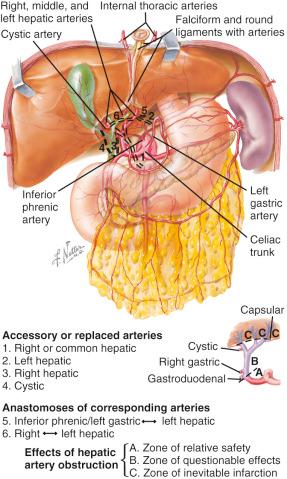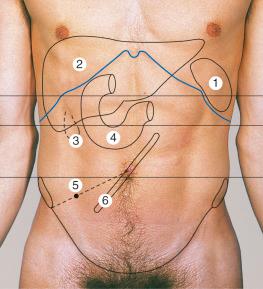Physical Address
304 North Cardinal St.
Dorchester Center, MA 02124
The omentum flap was one of the first free flaps reported in the literature but long before that, its use as pedicled flap for intra- and extra-abdominal reconstructions was well described. The popularity of the omentum flap has been variable over the past decades but new harvesting techniques have been developed that aim to reduce donor site morbidity.
In recent years, the superior epigastric flap has become a versatile perforator flap for coverage of locoregional defects. The concepts of angiosomes and perforasomes led to a better understanding of vascular territories, to a safer flap harvest, and therefore to an increased use of this fasciocutaneous flap.
The external oblique and the internal oblique muscle flap share not only similar characteristics but also the same dominant source vessel. They can be used as both free and pedicled flaps.
The blood supply to the omentum flap is equally provided by the right and the left gastroepiploic vessels. As the diameter of the right gastroepiploic artery is usually bigger than the one of the left side, the flap is preferably based on the right gastroepiploic vessels. Additionally, extensive dissection of the left gastroepiploic vessels may carry the risk of inadvertent injury to the spleen. The intra-abdominal arcade has four major branches: the accessory omental artery, the right omental artery, the middle omental artery, and the left omental artery. The middle omental artery anastomoses with the left and right omental arteries. This is an important consideration when the flap design requires lengthening of the omentum or splitting of the flap into several parts.

right gastroepiploic artery
Length: 20 cm (range 10–30 cm)
Diameter: 2.2 mm (range 1.5–3 mm)
The right gastroepiploic artery originates from the gastroduodenal artery. It travels along the greater curvature of the stomach and gives off the four major branches to the omentum, as well as multiple short branches to the stomach – the gastric arteries. It eventually anastomoses with the left gastroepiploic artery.
left gastroepiploic artery
Length: 20 cm (range 10–30 cm)
Diameter: 2 mm (range 1.2–2.9 mm)
The left gastroepiploic artery arises from the splenic trunk. It courses along the greater curvature of the stomach and anastomoses with the right gastroepiploic artery.
right gastroepiploic vein
Length: 20 cm (range 10–30 cm)
Diameter: 2.7 mm (range 2–3.4 mm)
The right gastroepiploic vein drains into the superior mesenteric vein. It runs from left to right along the greater curvature of the stomach and parallel to the right gastroepiploic artery. Its caliber is comparable with the size of the artery; however. it is often quite thin and care should be taken while handling it.
left gastroepiploic vein
Length: 20 cm (range 10–30 cm)
Diameter: 2.7 mm (range 2–3.4 mm)
The left gastroepiploic vein runs from the right to the left along the greater curvature of the stomach and parallel to the left gastroepiploic artery. It drains into the splenic vein.
none
none
The omentum flap can be harvested as a gastro-omental flap by including a patch of the greater curvature of the stomach.
Free flap or pedicled flap
Thin and pliable
Large surface area
Long pedicle
Angiogenic and immunogenic properties
Relatively fast and easy harvest
Robust blood supply
Donor site morbidity may be considerable as it requires laparotomy for access
Size and availability cannot be assessed preoperatively

Flap design varies according to defect size. The whole omentum or part thereof can be harvested based on the gastroepiploic vessels and one or more branches of the intra-abdominal arcade. As the flap cannot be combined with a skin paddle, it must be covered with a split-thickness skin graft (STSG) or regional skin flaps.
Free gastro-omental flap for oral or oropharyngeal reconstructions
Free omentum flap for reconstruction of extensive scalp, lower extremity (consider flow through flap) or head and neck defects
Pedicled omentum flap for chest wall, abdominal wall and breast reconstruction – pedicle can be tunneled subcutaneously or through small diaphragmatic opening
No general differences are in the design of flap when using it as pedicled or free. However, the harvesting technique (open vs laparoscopic) and closure of donor site may vary.
Length: Average 35 cm
Width: Average 25 cm
Thickness: Average 1 cm
The size of the omentum varies significantly with the size of the patient and previous intra-abdominal surgeries or infections. Folding the flap onto itself can increase its thickness.
Once the omentum is visualized, the area to be harvested is marked. Usually, the entire omentum is harvested.
Supine positioning of patient for harvest. Repositioning after flap harvest may be necessary according to site of defect.
General anesthesia.
An upper median laparotomy is performed. The abdominal cavity is explored and the omentum is inspected for surface area, volume, and pedicle length. It is elevated off the transverse colon and is mobilized on the gastroepiploic arcade. This dissection is performed in a thin areolar and avascular plane using blunt dissection and needle-tip cautery to ensure bloodless dissection. The lateral splenic attachments are divided as well as the short gastric vessels to free the omentum from the greater curvature of the stomach. The flap is based on the right or left gastroepiploic artery; the contralateral vessels are ligated. Care is taken to prevent kinking or twisting of the pedicle when transposing the flap into the chest wall defect.
Standard laparoscopic surgery techniques are used with four ports placed in the umbilical region, suprapubic region, and both lateral iliac fossa. CO 2 pneumoperitoneum of 10–12 mmHg is maintained during the procedure. The gastric wall is elevated and the right gastroepiploic artery is isolated. The short gastric arteries along the greater curvature are ligated until the left gastroepiploic artery is reached. The omentum is carefully released from the transverse colon preserving the mesocolon vascularity. The left gastroepiploic artery is ligated adjacent to the left colic flexure and the flap is evacuated through one of the ports.
As the gastroepiploic arteries give off several short branches to the greater curvature of the stomach, a patch of gastric mucosa can be included in the flap for oral or oropharyngeal reconstructions.
Laparoscopic harvest can considerably reduce the donor site morbidity.
After harvesting the omentum as a free flap, standard laparotomy or laparoscopy closure techniques are used.
When the omentum is harvested as a pedicled flap, a small defect must remain in the abdominal fascia to permit passage of the pedicle. This, by definition, creates an abdominal hernia. However, as long as it is not symptomatic it will not require intervention. Sutures are placed between the greater curvature of the stomach and the transverse mesocolon to minimize the chance of volvulus.
A drain is not usually necessary at the donor site.
Relative contraindications for the use of the omental flap are previous multiple intra-abdominal surgeries or previous intra-abdominal infections (peritonitis). If the decision is made to proceed, extra care should be taken to avoid injury.
The flap can be lengthened considerably by dividing the gastroepiploic artery between the right and the left omental artery. Vascularization of the entire flap is provided by the anastomoses between the left, right, and middle omental artery within the intra-abdominal arcades.
Reconstruction of extensive chest wall or sternal defects: the omentum can be transposed into the chest wall or sternal defect through a hole in the diaphragm or a fascial defect in the abdominal wall. The flap is covered with a STSG or local skin flaps. The arc of rotation of the flap reaches most defects on the chest and abdominal wall.
Reconstruction of extensive scalp or lower extremity defects, chronic avascular or irradiated wounds
For lower extremity reconstructions flow through flap designs can be considered to ensure perfusion of distal part of the limb
Reconstruction of the breast in Poland syndrome or implant coverage after mastectomy. Use laparoscopic technique whenever possible (see above). After ligation of left gastroepiploic artery, a small incision is made in the inframammary fold and a small subcutaneous tunnel is created up to the subcostal margin. The fascia and peritoneum are incised in the midline. The flap is pulled through the fascial gap, tunneled subcutaneously, and placed in the defect.
Head and neck reconstruction with gastro-omental composite free flap. The short gastric arteries are left intact while the left gastroepiploic vessels are ligated. The gastric patch is excised using a gastrointestinal stapling device taking care to avoid pyloric outlet.
Avoid heavy weight-lifting for 6–8 weeks.
General wound and flap care. If STSG had been used for flap coverage, first dressing change is done on POD 5.
An abdominal binder may be recommended for 4 weeks, no heavy weightbearing for 4 weeks. After pedicled omentum flaps a considerable abdominal wall hernia can develop. Although it may be cosmetically unsightly, it can be neglected as long as it is not symptomatic.
The omentum flap provides versatile, thin, pliable coverage for various defects and recipient sites. It has a robust blood supply as well as high angiogenic and immunogenic potential. It is most beneficial in defects with a large surface area, chronic avascular or irradiated wounds, or wounds with a high bacterial load.
If the flap can be harvested laparoscopically, the donor site is quite appealing and complications as abdominal wall hernias can be avoided. Pedicled flaps create an abdominal wall hernia by definition, as the pedicle has to be guided through a fascial gap but as long as they are asymptomatic no treatment is needed.
Large abdominal wall hernias can develop after pedicled omentum flaps. Additionally, all intra-abdominal procedures may result in adhesions of varying extent. Gravitational forces may cause sagging of the flap, especially in head and neck reconstructions. When using a gastro-omental flap for reconstruction of the oral cavity, extensive mucus and acid production may be troublesome. Spontaneous flap growth has been described after transposition.
The blood supply to the superior epigastric flap is provided by perforators of the superior epigastric artery (SEA) The SEA originates together with the musculophrenic artery from the internal mammary artery at the sixth intercostal cartilage. It passes behind the seventh costal cartilage, perforates the posterior rectus fascia, and enters the rectus abdominis muscle at a variable distance. After giving rise to the superficial SEA, a large musculocutaneous perforator that travels subcutaneously along the costal margin, the SEA gives off several perforators to the overlying skin. On average, 4–5 perforators can be found on the upper hemi-abdomen, most of them encountered in an area 2–6 cm from the midline and 0–10 cm below the xiphoid process. The diameter of the perforators is on average 0.82 mm and they are accompanied by a minimum of one vein. Location and number of perforators may vary significantly between individuals.
superior epigastric artery perforators
Length: 3.4 cm (range 1.5–7 cm)
Diameter: 0.8 mm (range 0.5–2 mm)
superior epigastric perforating veins
Length: 3.4 cm (range 1.5–7 cm)
Diameter: 0.8 mm (range 0.5–2 mm)
Innervation to the skin of this flap is through anterior and lateral cutaneous branches of intercostal nerves 5–9. However, the flap is usually planned as an islanded flap and therefore not innervated.
The superior epigastric flap is a fasciocutaneous perforator flap. Anterior rectus fascia can be harvested with the flap although this would weaken the abdominal wall.
Less invasive, no use of muscle
Primary closure of donor site
Relatively fast and easy harvest
Limited mobility
Perforator anatomy may be variable
Become a Clinical Tree membership for Full access and enjoy Unlimited articles
If you are a member. Log in here